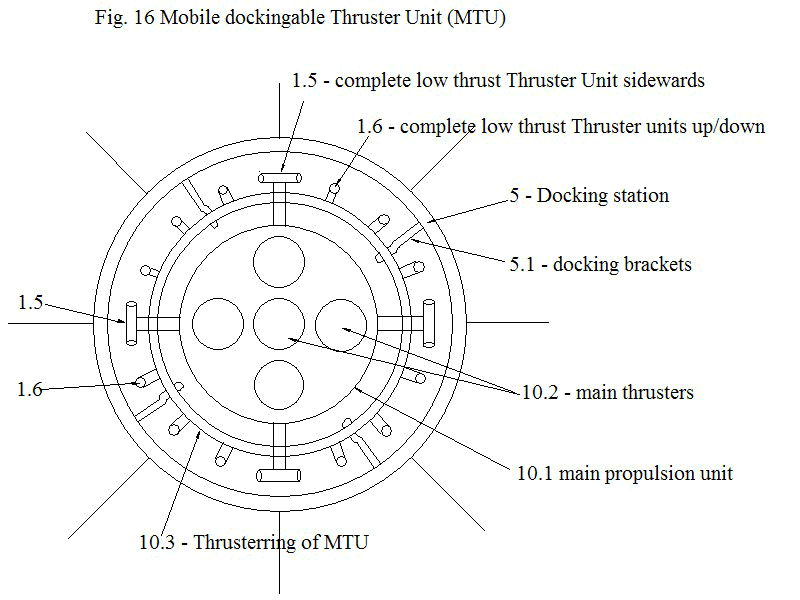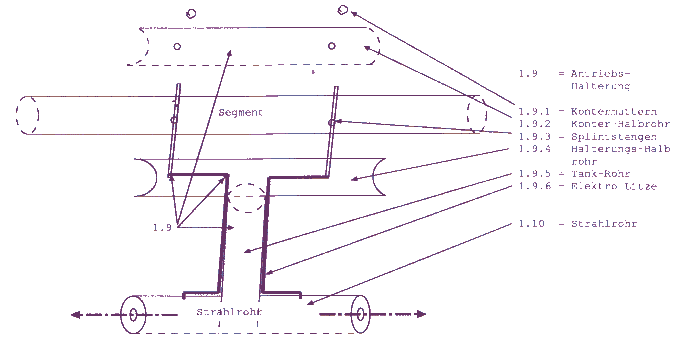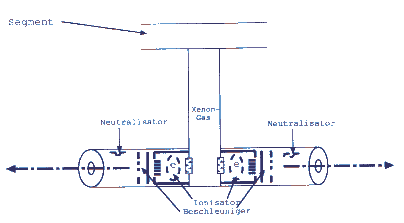
| POST & AUTHOR & Vision | RSS - Ring Skeleton Structure | LTH - Launcher Transport Head | EFO - Experimental Flying Object | RSC - Rotational Slingshot Catapult |
|
This system makes it possible to refuel a thrusterring-spacecraft with central docking station by switching mobile dockingable thruster units which are even able to dock at space fuel stations or land on asteroids for refuelling.
It allows also to combine low thrust propulsion like solar sail or solar electric propulsion with other kinds of propulsion like chemical, steam engine or nuclear thrust and change, park or discard the additional propulsion unit when needed.

The outmost ring structure (5) above is a single docking station which is held with thread/teathers in a thrusterring-spacecraft or solar-sail. Into this docking station which could also be a magazine docking station (take a look here) is the Mobile Dockingable Thruster Unit docked in, held by holding brackets (5.1). The Outer Thruster Ring (1) of the Mothership (which is typified by an stiff outer Ring as carrying structure of a flat, disklike spacecraft) is not shown here.
The Mobile Dockingable Thruster Unit consists of the main thruster unit (10.1) which carries the main thrusters (10.2) and the fuel supply for the main thrusters thought to give the mother ship an extra push.
The second ring (10.3) in the drawing serves as a handle for the motherships docking brackets and is a stiff pipe construction carrying several complete low thrust thruster units (1.5 and 1.6) which are designed to steer and maneuvre the Mobile Thruster Unit.
Those complete thruster units carry two thrusters each and a small fuel supply in itīs brackets (for instance xenon for Ion thrusters), making propulsion and steering independant of the main thruster unit supply.
As those two thruster of one unit are placed opposed to each other thrusting into the contrary direction it is possible to slow down or reverse each thrust without having to turn the spacecraft (for instance for landing or docking and start again).
The low thrust thruster ring with itīs complete thruster units (1.5 and 1.6) enables sensible docking and steering maneuvers while the main thruster unitīs (10.1) duty is it to push the mothership.

Thruster units, parts 1.9 are at the same time brackets and tank units for xenon-gas. Parts 1.10 are jet tubes consisting of two thrusters with outlet to opposed directions.

The two splints of the bracket 1.9 run completely through the segment-pipes and are boltet onto them with counter nuts. The splints are also conductors for the electric power yielded from the solar-cells near the thruster-unit. Half-pipes (could be from metal) 1.9.2 enfold the segment pipes to give this joints some more strength since they have to resist heavy rotational forces.

The bracket for the unit is at the same time tank for xenon gas
| POST & AUTHOR & Vision | RSS - Ring Skeleton Structure | LTH - Launcher Transport Head | EFO - Experimental Flying Object | RSC - Rotational Slingshot Catapult |
|